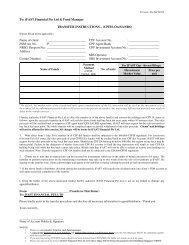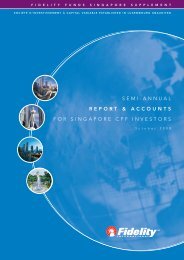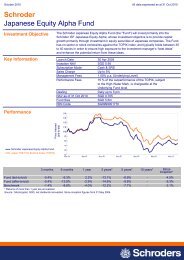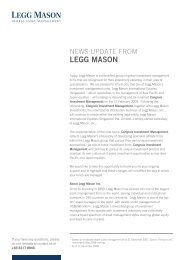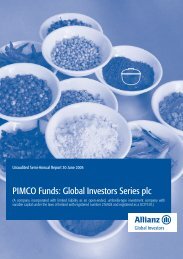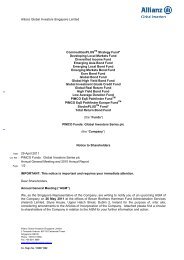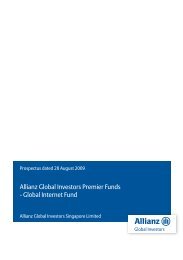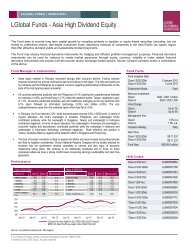Jpmorgan Funds - Fundsupermart.com
Jpmorgan Funds - Fundsupermart.com
Jpmorgan Funds - Fundsupermart.com
You also want an ePaper? Increase the reach of your titles
YUMPU automatically turns print PDFs into web optimized ePapers that Google loves.
JPMorgan <strong>Funds</strong><br />
Notes to the Financial Statements (continued)<br />
As at 30 June 2008<br />
The SICAV writes options on securities, futures and interest rate swaps (“swaptions ”). These options are settled in cash and subject the SICAV to unlimited risk of loss. The<br />
SICAV, however, is not subject to credit risk on written options as the counterparty has already performed its obligation by paying the premium at the inception of the contract. As<br />
of 30 June 2008, the SICAV had written options contracts outstanding as listed on its Schedule of Investments.<br />
h) Total Return Swaps<br />
The SICAV may enter into swap contracts in which the SICAV and the counterparty agree to exchange payments where one or both parties pay the returns generated by a security,<br />
instrument, basket or index thereof. The payments made by the SICAV to the counterparty and vice versa are calculated by reference to a specific security, index, or instruments and<br />
an agreed upon notional amount. Any such underlying security or instrument must be a transferable security and any such index must be an index of a regulated market. The value of<br />
the underlying securities shall be taken into account for the calculation of the investment and borrowing powers applicable to individual issuers. The relevant indices include, but are<br />
not limited to, currencies, interest rates, prices and total return on interest rates indices, fixed in<strong>com</strong>e indices and stock indices.<br />
Unrealised gains or losses are recorded under “Total Return Swaps at Market Value” in the Combined Statement of Net Assets. The changes in such amounts are included in the<br />
Combined Statement of Operations and Changes in Net Assets under “Net Change in Unrealised Gain/(Loss) on Total Return Swaps”. When a contract is closed, the Realised<br />
Gain/(Loss) is recorded under “Net Realised Gain/(Loss) on Total Return Swaps” in the Combined Statement of Operations and Changes in Net Assets.<br />
i) Interest Rate Swaps<br />
An interest rate swap is a bilateral agreement in which each of the parties agree to exchange a series of interest payments for another series of interest payments (usually<br />
fixed/floating) based on a notional amount that serves as a <strong>com</strong>putation basis and that is usually not exchanged.<br />
The market values are recorded under “Interest Rate Swaps at Market Value” in the Combined Statement of Net Assets.<br />
j) Credit Default Swaps<br />
ACredit Default Swap is a credit derivative transaction in which two parties enter into an agreement, whereby one party pays the other a fixed periodic coupon for the specified life<br />
of the agreement. The other party makes no payments unless a credit event, relating to a predetermined reference asset, occurs. If such an event occurs, the party will then make a<br />
payment to the first party, and the swap will terminate. The value of the underlying securities shall be taken into account for the calculation of the investment and borrowing powers<br />
applicable to individual issuers.<br />
The market values are recorded under “Credit Default Swaps at Market Value” in the Combined Statement of Net Assets.<br />
k) To Be Announced Securities (“TBA”)<br />
TBAs are related to mortgage backed securities issued by government sponsored agencies. These agencies usually pool mortgage loans and sell interests in the pools created. TBAs<br />
relate to future pools of these agencies that are bought and sold for future settlement for which either the interest rate or the maturity date is not yet fixed. TBAs are separately<br />
disclosed in the Schedule of Investments.<br />
The Sub-<strong>Funds</strong> may enter into Dollar Rolls, principally using To Be Announced (“TBA”) Securities, in which the Sub-<strong>Funds</strong> sell mortgage-backed securities for delivery in the<br />
current month and simultaneously contract to repurchase similar, but not identical, securities at an agreed-upon price on a fixed date. The Sub-<strong>Funds</strong> account for such Dollar Rolls<br />
as purchases and sales and receive <strong>com</strong>pensation as consideration for entering into the <strong>com</strong>mitment to repurchase. The Sub-<strong>Funds</strong> must maintain liquid securities having a value<br />
not less than the repurchase price (including accrued interest) for such Dollar Rolls. The market value of the securities that the Sub-<strong>Funds</strong> are required to purchase may decline<br />
below the agreed upon repurchase price of those securities.<br />
The Sub-<strong>Funds</strong> had TBA Dollar Rolls outstanding as of 30 June 2008, which are included in Amounts Receivable on Sale of TBAs and Amounts Payable on Purchase of TBAs in<br />
the Combined Statement of Net Assets.<br />
l) Price Lock Swaps<br />
The SICAV may enter into swap contracts in which the SICAV and the counterparty agree to exchange payments where one or both parties pay the price difference generated on a<br />
security, instrument, basket or index thereof. The payments made by the SICAV to the counterparty and vice versa are calculated by the price difference (current asset price and<br />
locked price) of a specific security, index, or other instruments and an agreed upon notional amount. Any such underlying security or instrument must be a transferable security and<br />
any such index must be an index of a regulated market. The value of the underlying securities shall be taken into account for the calculation of the investment and borrowing powers<br />
applicable to individual issuers. The relevant indices include, but are not limited to, currencies, interest rates, and other asset prices.<br />
The market values are recorded under “Price Lock Swaps at Market Value” in the Combined Statement of Net Assets.<br />
m) Forward Rate Agreements<br />
AForward Rate Agreement is a forward contract in which one party pays a fixed interest rate, and receives a floating interest rate equal to a reference rate (the underlying rate). The<br />
payments are calculated over a notional amount over a certain period, and netted. The reference rate is fixed one or two days before the termination date, dependent on the market<br />
convention for the particular currency.<br />
The market values are recorded under “Forward Rate Agreements at Market Value” in the Combined Statement of Net Assets.<br />
n) Consolidation of Mauritian Subsidiary<br />
All in<strong>com</strong>e, expenses, receivables, payables and investments of Flagship Indian Investment Company (Mauritius) Limited (the “Subsidiary”), a wholly-owned subsidiary of JPMorgan<br />
<strong>Funds</strong>, are consolidated into the Combined Statement of Net Assets and the Combined Statement of Operations and Changes in Net Assets of JPMorgan <strong>Funds</strong> - JF India Fund. Securities<br />
owned by the Subsidiary are individually disclosed in the Schedule of Investments of JPMorgan <strong>Funds</strong> - JF India Fund. Inter<strong>com</strong>pany balances are eliminated on consolidation.<br />
The use of the Mauritius Subsidiary and the tax treatment it is afforded, is based on the law and practice currently in force in the relevant countries, as understood by the Board of<br />
Directors. It is subject to any future changes and such changes may adversely affect the returns of the Sub-Fund. This includes any circumstances where the India/Mauritius Double<br />
Taxation Treaty may not be applied or ceases to be applied, resulting from, inter alia, any future ruling by the Indian tax authorities. Should the treaty not be applied, or cease to be<br />
applied, interest on securities listed on an Indian stock exchange would be subject to tax at a maximum rate of 20%. Capital gains on disposal of such investments would be subject to tax<br />
at rates of 0 to 30% in respect of listed securities depending on the length of time the relevant investment has been held.<br />
3. Value of Financial Instruments and Associated Risks<br />
The SICAV entered into forward foreign exchange contracts, financial futures contracts, options and swaps which, to varying degrees, represent a market risk in excess of the<br />
amount reflected on the Combined Statement of Net Assets. The amount of the contracts represents the extent of the SICAV’s participation in these financial instruments. Market<br />
risks associated with such contracts arise due to the possible movements in foreign exchange rates, indices, and security values underlying these instruments.<br />
Investment in fixed in<strong>com</strong>e securities is subject to interest rate, sector, security and credit risks. High yield bonds are lower-rated securities and will usually offer higher yields to<br />
<strong>com</strong>pensate for the reduced creditworthiness or increased risk of default that these securities carry.<br />
Other market and credit risks include the possibility that there may be an illiquid market for the contracts, that a change in the value of the contracts may not directly correlate with<br />
changes in the value of the underlying currencies, indices, or securities, or that the counterparty to a contract defaults on its obligation to perform under the terms of the contract.<br />
In emerging and less developed markets, in which some of the Sub-<strong>Funds</strong> will invest, the legal, judicial and regulatory infrastructure is still developing but there is much legal uncertainty both<br />
for local market participants and their overseas counterparts. Some markets may carry higher risks for investors who should therefore ensure that, before investing, they understand the risks<br />
involved and are satisfied that an investment is suitable as part of their portfolio. In some markets there may be no secure method of delivery against payment which would minimise the<br />
exposure to counterparty risk. It may be necessary to make payment on a purchase or delivery on a sale before receipt of the securities or, as the case may be, sale proceeds.<br />
30



